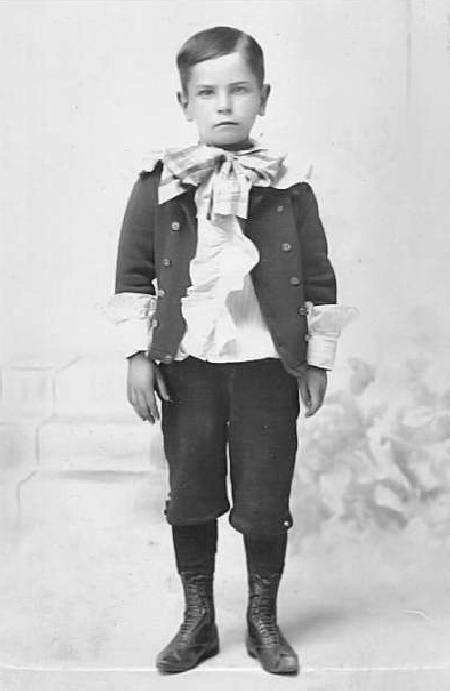
Children's Footwear: Boot Types

Figure 1.--Boys in the late 19th century commonly wore high-top shoes with fancy suits. Here it is difficult to differentiaste between high-top shoes and boots. Here I am not sure if this boy's footwear would have at the time be called a shoe or a boot. Boys also wore heabt boot-like shoes to school.
|
|
Boys wear all kinds of different boots and boot-like footwear. Here are assessment is somewhat complicated that many boys in the late-19th and early 20 century wore boot-like shoes.
We note quite a range of different types such as cowboy boots galoshes, rubbers, snow boots, wellies, and others. Some like cowboy boots are very poular. Others like galoshes, boys hated to put on. Skinheads made Dr. Martins popular. Our knowledge of boot types is very limited. Hopefully our readers will provide more information to expand our very basic understanding of this topic.
Cowboy Boots
Cowboy boots are today associated with Texas and the West. Every American boy in the 1940s and 50s, however, has worn or at least wanted to wear cowboy boots when they were little. Some grow up to be presidential candidates and still want to wear them. I remember how I wanted to wear by new cowboys boots everywhere when I got a pair in the second grade. I got into trouble though because they made so much noise in the hallway.
Galoshes
Galoshes look like boots, but are actually a kind of overshoe. Many American children remember the galoshes that they had to wear as children. Galoshes in the 1930s and 40s were bigheavy rubber boots with clasp-like closures. An American reader writes, "I remember how I hated ny golashes as a boy. Every time it rained there would be a test of wills between my mother and I about wearing those galoshes to school. She wanted me to wear them to protect my shoes. I disliked them, because they were difficult to take off once I got to school and to put back on at the end of the day. More details are available on my individual account page."
High-top Shoes
Shoes in the late 19th and eraly 20th century were often high-topped, extending above the ankles. This makes it some what complicated in differentiating between shoes and boots. Here we note high-top shoes both for outdoor wear, but also for dresswear wear. We note many boys in fancy suits wearing these high-top shoes.
We are not sure at this time when a definite detinction developed between boots for outdoor work and activities like hunting developed as destinct from shoes. Certainly for many boys into the 20th century they might only have one pair of footwear, often boot-like shoes. These often were the high-top style extending above the ankles. The destinctive feature of boots seems is that it not only covers the foot, but part of the leg above the ankles. Here there is considerable variation as to how much of the leg was covered. We have noted some boots popular for hunting or outdoor wear that laced up covering much of the calf. Other boots only extended a little above the ankles. The best modern example here are Dr. Martins which were adopted by the skinheads.
Snow Boots
An American HBC contributor reports that long before he had heard of L.L. Bean, he was keeping his tootsies wonderfully warm with those in expensive vulcanized rubber boots, similar to English wellies. They came half way up the shin and were fastened with black metal buckles. These boots didn't have tounges, or rather the tounges were sewn into the boots themselves without any separation. They were constructed so that they were very floppy at the upper end. You'd wrap your pants, of course we all wore long pants to school in the 1950s, around your ankles and stuff them down deep inside the boots. The buckles--running up the center of the boots, from the instep to the top, resemnled small lengths of railway track. You'd hook one side to the other and clamp the apartaus tight. There were several degrees of tightness, depending on how much mussle you had, depending on how far over you could get the hook. The lockining-in sound of a boot clamped all the way over, to the last hinge, was the sound of warmth itself.
Every British boy has worn Wellington boots or "wellies" at some time in his life. Wellies are knee-high rubber boots. I'm not quite sure why they were called Wellington boots, presumably they looked like the high boots worn by the famed Duke of Wellington--although his were not rubber boots. Wellington is a brand name and are actually quite pricey. The boots are also called garden boots or gum boots. These rubber boots have some kind of netting imbedded in the rubber). They have ribbed soles and reenforced arches. There are other manufacturers such as Tingley in New Jersey. Wellies were introduced to Americans of course by Christopher Robin. In a country like England where it rains so much, they were very useful footware. American boys also wore rubber boots, but they were not nearly as common as in England.
HBC

Navigate the Historic Boys' Clothing Web Site:
[Return to the Main boot page]
[Return to the Main footwear page]
[Introduction]
[Activities]
[Biographies]
[Chronology]
[Clothing styles]
[Countries]
[Bibliographies]
[Contributions]
[FAQs]
[Glossaries]
[Satellite sites]
[Tools]
[Boys' Clothing Home]
Navigate the Historic Boys' Clothing Web chronological pages:
[The 1800s]
[The 1940s]
[The 1880s]
[The 1900s]
[The 1910s]
[The 1920s]
[The 1930s]
[The 1940s]
[The 1950s]
[The 1960s]
[The 1970s]
Navigate the Historic Boys' Clothing Web style pages:
[Skelton suits]
[Tunics]
[Eton suits]
[Kilts]
[Sailor suits]
[Knicker suits]
[Short pants suit]
[Long pants suits]
[School sandals]
Created: 7:37 PM 6/12/2005
Last updated: 7:37 PM 6/12/2005



